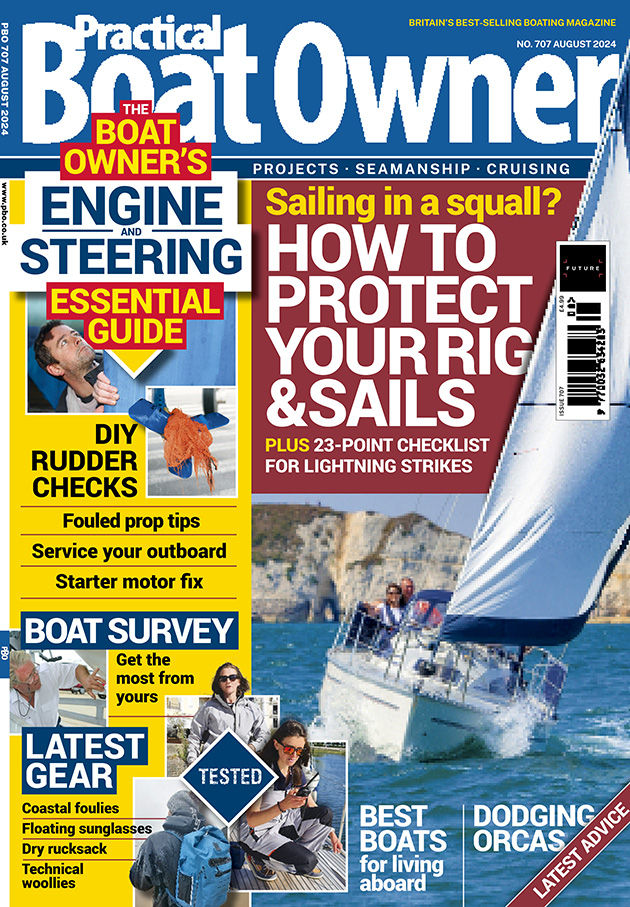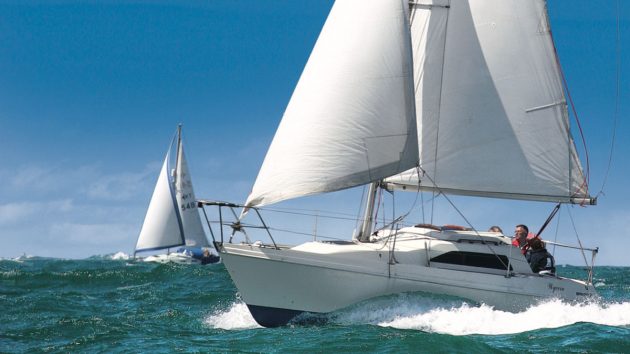Sailing efficiently when the wind comes astern doesn’t mean you have to fly a spinnaker or cruising chute. David Harding shows how to make the most of your upwind sails on downwind legs
The modern Bermudan rig evolved for sailing upwind. Almost anything that floats will get itself downwind eventually, so rig developments have often been geared towards windward efficiency.
Enthusiasts of alternative rigs, such as the junk, will feel very self-satisfied at this stage because going downwind simply means bearing away and easing the sheets.
As often as not, they will then sail straight past any equivalent Bermudan-rigged boat that’s not flying a spinnaker.
If, as the owner of a Bermudan rig, you don’t want to fly a cruising chute or spinnaker, you have to make the best of a configuration designed principally for going the other way.
It might be tempting not to give a lot of thought to broad reaching or running, but getting your sails working properly will make the boat more comfortable and easier to steer as well as faster.
In this article, we’re illustrating the do’s and the don’ts using two different boats: Victor Budden’s fractionally-rigged MG 335, Virago, and David Pugh’s Contessa 26, Red Dragon, with her masthead rig and relatively bigger headsail.
Sail trim: Present your sails to the wind

As the wind moves aft, there comes a point when laminar flow is lost and the sail becomes stalled
As the wind moves abaft the beam, there comes a point when the sails no longer act as aerofoils: they stop generating lift and pulling the boat along, instead becoming windbreaks and pushing it along.
You will know when this happens with the mainsail because the leech telltales refuse to fly any more.
That’s a sign that the air is no longer flowing across the leeward side of the sail, but has become turbulent and is forming eddies in its lee.
With a typical cruising yacht it will happen on a broad reach, and that’s when you need to start thinking of your sails in a different way.
At this point, the most important factor is to make sure the sheet is eased to present the sail square to the wind.
On many boats, this will be impossible as the wind moves further aft because the boom’s angle will be limited by the swept-back spreaders or aft lowers.
Nonetheless, you can make sure the kicker is tight enough to hold the boom down and take most of the twist out of the sail: too often you see boats with the mainsail against the upper rigging but the boom is still set as if the wind is on the beam. It’s generally a case of ‘less sheet tension, more kicker’.
Sail trim: Broad Reaching
On a fractionally-rigged boat with most of the sail area in the mainsail, it’s vital to keep the main working downwind

Here, Virago is on a very broad reach. The headsail is collapsing in the lee of the mainsail, which is sheeted in far too tight.

Now the mainsail has been eased, but still not far enough, and the kicker is too loose so the upper section of the mainsail is against the rigging. Only a tiny percentage of the total sail area is doing anything useful.

This is better: the mainsail has been eased and the kicker tightened to take the twist out of the sail. At the helm, Victor has also headed up a few degrees – just enough to get the headsail filling.
Sail trim: Running
On a masthead-rigged boat with a relatively smaller mainsail and larger headsail, such as the Contessa 26, it’s even more important not to blanket the headsail – especially if the mainsail isn’t working efficiently either.

Here, once again, the main is over-sheeted and over-twisted: too much sheet, too little kicker. It’s not working properly and is also taking the wind from the headsail.

From astern, it’s easy to see how little sail is presented to the wind. An over-sheeted main also increases the risk of a gybe.

This is the answer! East the mainsheet, tension the kicker and goose-wing the headsail to bring it into clear air.
Goose winging

Even if you don’t use a spinnaker, having a spinnaker pole with an uphill and downhaul allows the headsail to be goose-winged far more efficiently than it can otherwise.
A headsail might stay goose-winged without a pole’s help in steady winds and flat water, given accurate helming, but if un-poled, it’s likely to spend at least half its timing collapsing and filling again. Besides, a pole projects the sail further.
An uphill and downhill mean you can set the pole’s height and, if you run an extra sheet from the clew through the pole, you can manoeuvre if necessary just by casting off the extra sheet because the normal sheets will remain woven as normal.
If you have to gybe, tack or harden up in a hurry, you can leave the pole in place and sort it out later.
With a suitably long pole you can sail not only dead downwind but also harden up to broad reach, keeping the headsail working on the windward side when, on the leeward side, it would be collapsing under the mainsail.
Racing sailors will sometimes resort to a poled-put headsail in very heavy weather.
Goose-winging using an extra sheet

It might look complicated, but it’s not: just a pole with an uphaul and downhaul on bridles top and bottom, plus the two headsail sheets (not doing anything) and the extra sheet attached to the clew, through the jaws of the pole and aft to the winch.
Downwind tips and techniques
Flying twin headsails

There are other ways to sail efficiently downwind that don’t involve special downwind sails or an alternative type of rig.
Twin headsails (each hanked on to its own forestay, or on a twin-grooved headfoil) are one solution, as shown on this Verl 33.
The owners cruise two-handed, and when the wind picks up they simply drop the mainsail on downwind legs, leaving the windward headsail poled out and the leeward one sheeted normally.
A mainsail, especially on a boat with swept spreaders, exerts a rounding-up moment in fresh downwind conditions, so getting rid of it and being pulled along by twin headsails is a fast, safe and easy-to-manage solution that also avoids the mainsail chafing on the spreaders.
Sailing the angles

If you don’t pole out the headsail or have an alternative arrangement, it’s especially important to avoid the ‘grey’ area downwind: the angle where the headsail is collapsing under the mainsail.
It’s often faster, and certainly more comfortable, to sail a little higher to keep the headsail filling, and then to bear away on to a run so you can goose-wing – wind and sea-state permitting – or gybe and go back the other way.
Using the waves

Almost any boat will pick up speed with a wave underneath it, so it’s worth using the waves when sailing downwind.
The faster you’re moving before each wave arrives, the better the chances of surfing down it, so reach up between them to build the apparent wind and get the
boat going.
Then, when you see a good wave approaching over your quarter, point the bow down into the trough ahead of you.
Once the wave has passed underneath you, reach up again so you’re ready for the next one.
Racing sailors do it all the time, but even if you’re not in a hurry it makes life much more fun – and in heavy weather, it’s also safer to take big waves on the stern rather than on the quarter, so you’re less likely to be broached.
Continues below…
Cruising chute or spinnaker? We compare both sails on the same boat on different points of sail
Many cruising sailors favour a cruising chute over a spinnaker – but how do the two sails compare on different…
How to rig a spinnaker on a small yacht – what you need and where to fit it
If you want a spinnaker, but don’t have the necessary fittings or equipment on your boat, where do you start?…
Broaching on a boat and how to prevent it
When the breeze picks up, how do you stop your boat taking charge and going where it wants? David Harding…
Sail boat rigs: the pros and cons of each popular design
Peter Poland looks at the history of popular rig designs and how the different types affect boat performance
Troubleshooting your telltales
Telltales: how they work, how to use them to steer a close-hauled course and how to interpret their behaviour
Enjoy reading Sail trim: Sailing downwind without a spinnaker?

A subscription to Practical Boat Owner magazine costs around 40% less than the cover price.
Print and digital editions are available through Magazines Direct – where you can also find the latest deals.
PBO is packed with information to help you get the most from boat ownership – whether sail or power.
-
-
-
- Take your DIY skills to the next level with trusted advice on boat maintenance and repairs
- Impartial in-depth gear reviews
- Practical cruising tips for making the most of your time afloat
-
-
Follow us on Facebook, Instagram, TikTok and Twitter









